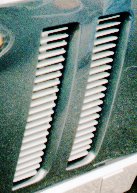

Some Italian cars appear to have lost their original Italian Style wings early on. The typical West Bromwich wing below may well be the replacement fitted to 119/011 around 1970 by the factory, after a front end collision early in life. This shot of a later style wing highlights the differences:

[It appears that perhaps all MK1 cars should have more pointed domes
to the wheel nuts, accentuating the shape of the pointed MK1 bumper overriders.]
The chrome trim round the windows and doors, and door handles in particular was of a much higher quality on the Italian cars. FF 36 currently has the superior quality door handles, but the poorer West Bromwich trim around the doors is evident. Metric hinge bolts on the rear boot hinges, and opening quarterlight mounts appear on at least some early cars. Some Italian cars had wood veneer on the door and rear panels. FF's 11 and 13 may be Italian cars that lacked this feature. 11 and 13 appear to have left the factory with heated rear screens. Earlier cars had a plain glass rear screen with an electric warm air blower. The Italian door and rear window rubbers were also backed with aluminium all the way round, and the sill guards were etched or engraved with "Jensen", instead of the cloth backing and plain spotted Aluminium on the West Bromwich cars.
I have spotted two types of sill guards from the early cars. Both appear to be made from anodised Aluminium sheeting (about the same time Ducati used a similar coating on their polished aluminium alloy Motorcycle engine cases), engraved and in some cases etched with the Jensen Logo. The special finish on the sheet metal is often polished off by restorers attempting to remove scratches in the soft trims. Unfortunately, though the restored trims look fresher, the contrast between the bare etched/engraved areas and the coated sheet is to some extent lost. Unfortunately, I have not seen a perfect early sill trim with the original finish, and a restored trim still looks splendid. Here are the two types of (tatty unrestored) trim, showing where the finish has worn away in places revealing the bare aluminium below:
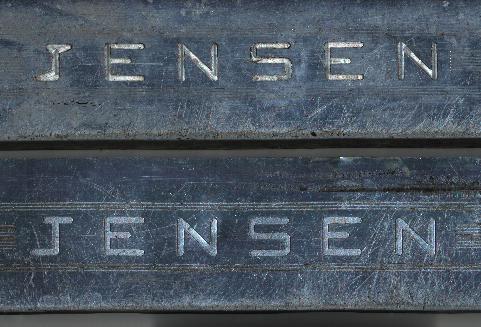
The top trim is of the milled or engraved type, and the bottom one appears to be acid etched. The difference is most marked at the ends of the letters. Also the style of J is completely different.
Vignale Bonnets were lined with this splendid padded soundproofing (again 119/004):

Heavier, metal window lifter switches, and a different style clock are found on early FF's.
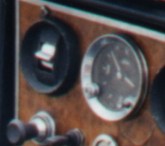
Opening front quarter lights (See knob above passenger door handle in photo below) were fitted to early cars. A two tone beige-cream and black dash was a typical early feature. Beige trim was also used around the rear handrail and inside lights, next to the headlining.
Very early FF's had no park setting on the transmission stick. This car has been left in Neutral, and with a badly adjusted handbrake! A new boxed Champion J11Y spark plug sits next to the gear selector. This interior is actually quite poor in places, as a result of being left in the open for over 6 years. Neats foot oil is being used to soften the sun dried leather.
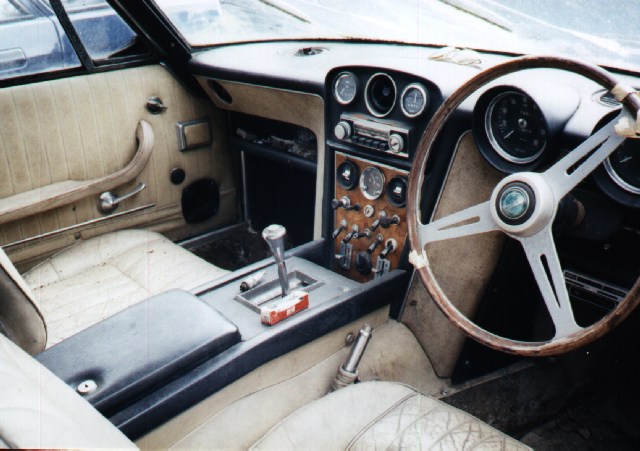
The boot on some early cars was fitted with a small handle allowing it to be lifted more easily. This may have been before the fitment of the small spring lifters that allow fingers to be placed underneath the rear lip:
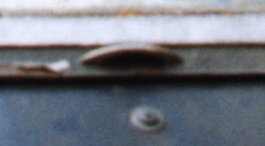
Many cars seem to have lost this. This is a photograph of the handle on 119/036. If you have an early car, look for the holes and tell me what you find. When I first saw this. I did not believe it was an original feature!
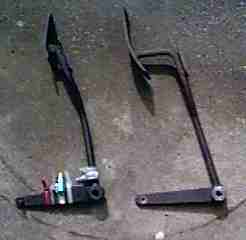
Note how the early throttle pedal on the left has a much lower profile. I prefer this early pedal setup, as I have quite long legs... I have not compared brake pedals, as this has not been convenient. Early pedal is from 119/011, later pedal (right) is from 119/123
Much of the ideas for the text here came, or was triggered by conversations
with the FF registrar, Ulric Woodhams, as I checked features of 119/011
for his records. Ulric has owned many FF's, including 119/002, the second
prototype. However, Ulric has not seen this page, and I hope the reader
will e-mail me with corrections, additions and stories as appropriate.
This page should be regarded as a working draft. As always, no responsibility
as to the accuracy of ANY information in the FF page is assumed by the
FF home page. John Wild,
[email protected]